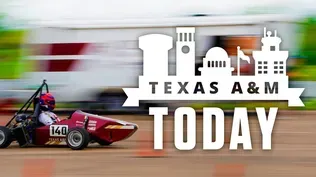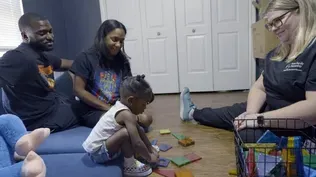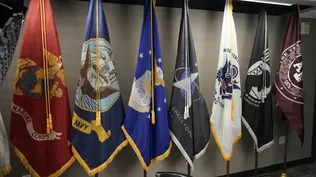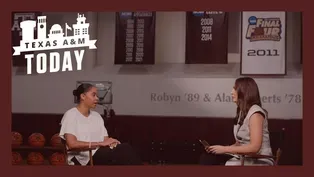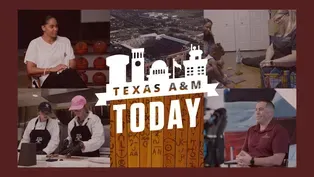
Ep. 4 - Supporting People at Texas A&M
Season 2 Episode 4 | 25m 36sVideo has Closed Captions
See how Texas A&M excels at supporting Texans in all walks of life.
In Episode 4, learn about the hundreds of people that come together to create a safe gameday environment at Kyle Field. See how Texas A&M works to support student veterans in all areas of life and learn about a program for new mothers in need of resources. Find out how experts get paid to eat in A&M’s Sensory Lab and check out a special Q&A with Aggie Women’s Basketball coach, Joni Taylor.
Problems with Closed Captions? Closed Captioning Feedback
Problems with Closed Captions? Closed Captioning Feedback
Texas A&M Today is a local public television program presented by KAMU

Ep. 4 - Supporting People at Texas A&M
Season 2 Episode 4 | 25m 36sVideo has Closed Captions
In Episode 4, learn about the hundreds of people that come together to create a safe gameday environment at Kyle Field. See how Texas A&M works to support student veterans in all areas of life and learn about a program for new mothers in need of resources. Find out how experts get paid to eat in A&M’s Sensory Lab and check out a special Q&A with Aggie Women’s Basketball coach, Joni Taylor.
Problems with Closed Captions? Closed Captioning Feedback
How to Watch Texas A&M Today
Texas A&M Today is available to stream on pbs.org and the free PBS App, available on iPhone, Apple TV, Android TV, Android smartphones, Amazon Fire TV, Amazon Fire Tablet, Roku, Samsung Smart TV, and Vizio.
Providing Support for PBS.org
Learn Moreabout PBS online sponsorshipThe Texas A&M Today Show is made possible thanks to Grow College Station.
- Howdy from Texas A&M.
We're on a mission to find the best and brightest at Texas A&M, taking you behind the scenes of one of the nation's largest universities.
In today's episode, we see how Texas A&M thrives at supporting Texans in all walks of life.
- [Man] From the way it's designed to the tradition to the game day pageantry.
There's nothing like game day at Kyle Field.
- [Woman] We are developing a relationship with you.
We want to get to know you.
We wanna help you achieve your dreams.
- [Man] A&M's offered me so much opportunity to live and live up to my potential, and I want nothing more than to give back to the school.
- Welcome to campus.
- Welcome to Texas A&M Today.
Howdy.
I'm your host, Chelsea Reber, coming to you today from Kyle Field.
With 102,733 seat,.
it's the fourth largest stadium in the United States and the largest in the southeastern conference.
And we start our episode here with football.
Not the on field play or the press conference banter, but the background operations that allow each home game to take place.
Hundreds of people work together in an attempt to keep game day safe for the players, coaches, and fans.
And we got a rare peak behind the scenes.
(soft music) - Kyle Field has a capacity of 102,733.
That makes it the largest stadium in Texas, the largest stadium in the SEC, and it's the sixth largest sports stadium in the world.
It's right here at Texas A&M in College Station, Texas.
(upbeat music) We have the Corps marching around campus.
Tailgating is everywhere.
Nobody's got a bigger student section in the country than Texas A&M.
The camaraderie from former students, current students, students who hope to come to A&M one day.
It all happens at football game day.
Seven Saturdays a year.
We're charged with overseeing all the home athletic events.
There's so many things that are going on on game day.
It takes a massive team.
We have, you know, weekly meetings with more than 100 people in them, university stakeholders from all areas of campus and the community and really our federal partners as well.
And so many things are happening behind the scenes that fans may never experience.
Yet, they're experiencing it.
Their safety and wellbeing is being planned out the whole year.
Our command center is very robust.
We have representatives in this room ranging from the FBI to a joint terrorism task force, to folks that are representing different law enforcement agencies in town, medical, transportation, safety, emergency management.
We've got everybody represented in one area.
- The most important reason to have an emergency plan is to make sure that when something happens, we have all of the relevant stakeholders together, located in one location.
We have an understanding of whose responsibility is it to make critical decisions, life safety decisions, right?
Actually much of the role of emergency management is prior to game days.
So a lot of what we're doing prior to is the week of a game we start to put together, the emergency management team starts to put together what we call our event action plan.
And so this is a document that contains all of the relevant information for that particular game.
- I think that our partnerships that we have here with other entities on campus and how we work with them day in and day out, as police is very unique for our campus.
So all of the work that we put in beforehand allows us to have a great experience during game day, allows our fans to have a great experience during game day and our work to try to keep them safe.
We have all of these opportunities to help people with life issues that confront them.
That is our why as a department.
And and I truly believe in that and that's what I stress to our department that in any interaction that we have, how can we help people?
- There's just so much that goes into the game day experience that I think that fans don't necessarily know or realize or sometimes even appreciate.
We set up several hours before gates open.
We're here several hours after the game ends, all to ensure that the fans have the safest experience possible and that if a small emergency arises that they're taken care of.
- You know, just really helping our fans have a great experience while they're here from the local law enforcement, state law enforcement, our FBI counterparts and all of the other entities across campus that come together to make this a great experience here on Aggie Game Day.
So it's worked well.
We are really good at it and I'm proud of what everybody's doing.
- Our ultimate goal is for everybody to come, enjoy their time here, leave as safely as possible.
It takes a lot of different groups, you know, to be able to do that.
And you know, I'm just really proud to be part of the team that gets to be part of that experience.
It's something that I've done for 20 years now, since I was a student volunteer with university EMS I have worked football games in the command post.
So it's something that I love and I'm really proud of and I'm thankful that I've had that opportunity just to work with amazing people seven times a year.
(soft music) I hope fans appreciate when they come in, it's not just winning and losing on the field, that the whole experience for them has been reviewed and analyzed and worked on year round.
- Pregnancy, birth and early childhood can be a daunting time, especially for first time mothers in need of resources.
Enter Nurse Family Partnership from the Texas A&M School of Nursing.
Specially trained nurses empower families in our community through home visits, giving them support they may not have received any other way.
(soft music) - Nurse Family Partnership is really what I consider kind of a jewel in the crown for the school of nursing.
We bring first time moms who are low income and they get paired with the registered nurse early in the pregnancy and that nurse will follow them through the entire pregnancy all the way until their baby turns two.
So it's a long-term relationship with the nurse.
So we like to think of it as the women who are enrolled in the program as having their own personal nurse who's gonna really guide them through this whole pregnancy journey and then beyond for the first two years.
We started our program in September, 2021. and it's actually a national program that exists in more than 40 states across the US, even international.
So we have five full-time RNs.
One of the requirements of the program is that the nurses have a BSN, or a Bachelor of Science in Nursing.
So they really are required to be, when I say highly experienced, highly educated, highly trained, they really are.
- My name is Sarah Daley and I am a nurse home visitor for Nurse Family Partnership at Texas A&M School of Nursing.
I have been in this role for a year now and before that I was a postpartum nurse for I think five years.
And then before that I did med surg for two and oncology for one.
My favorite part about the job at the hospital was doing discharges with the moms before they go home and doing that teaching.
And so I was like, wow, this job is literally taking the favorite part about my job and doing just that.
So a big motto of Nurse Family Partnership is meeting the patient where they're at.
- The content of the visit is gonna be driven by that pregnancy or postpartum stage that the client is in.
That's one great thing about coming in the home is that we get a feel for how their family dynamic is and get to know them a little bit better where they're comfortable.
So they're not uncomfortable sitting in, you know, a doctor's office.
Our normal caseload is about 25 and we've ramped up in the past year.
So I've gained 20 clients in the past year and it's been really rewarding to see these moms access this and realize that they're capable of so much more than just a statistic.
So Rakhi and Ashley were actually my first client.
Rakhi is an incredible, she is very, she's very small for her age, but her development is through the roof.
She's always been at least one month ahead based on developmental tendencies when we do screenings.
And a lot of it has to do with with Ashley.
- I'm Ashley and this is my daughter, Rakhi.
I was just looking to get some information on maybe a doula or something a little more comfortable, maybe at home.
And when I was looking, I ended up coming across a read on NFT, not knowing what it was, got a little information on it and decided to sign up just to kind of, you know, give it a test run.
And I ended up joining the program and that was two and a half years ago.
And now I'm here.
She usually will bring the toys for Rakhi to play with and then for me, just letting me know if there's anything that I may need, she's there to help.
- We make sure that they know all the resources that they actually do have.
They don't, a lot of times they don't realize how much that they actually have access to.
- As a new parent, I think it would be really good to know the resources that you have in front of you.
So I would definitely recommend it for new parents.
And it's free.
It's free, at no cost.
So whatever you may need, like, the help is there so you know it's always great to have any kind of help, especially being a parent.
- Thank you daddy.
- Thank you Daddy.
- You can plan and plan and plan and still not be ready.
It doesn't matter.
Life throws unexpected turns all the way.
But the good news is, is that I'm here to help you.
- [Sarah] What's this one?
- [Rhaki] Froggy - [All] Froggy!
- If you know a soon-to-be mom that could benefit from this program, we've put an application link on the Texas A&M Today Show page on our website.
Now it's time for an Aggie fact.
(drumming) The main stairwell of the Kleberg Center pays homage to the cattle industry.
When Kleberg was built on the west side of campus in 1978, 254 oak planks were placed on the walls, one for each Texas County.
At the dedication, cattle raisers from across the state were invited to bring their branding irons and burn their ranch brands onto the wall.
The response was so overwhelming, the brand new fire alarm had to be turned off and bathroom toilets became cooling spots for hot irons.
Some of the state's most iconic ranches such as King Ranch, XIT Ranch, and Wagner Ranch are among nearly 2,500 brands that line the walls to this day.
Getting paid to eat, a dream for many, but at Texas A&M, it's a reality, at least for a few people with well-trained palates.
(soft music) Tucked away in the corner of the Kleberg Center is a lab dedicated to taste.
Sit through 12 months of training and you could taste the next type of peanut butter, spinach, steak, or antelope.
It's all in an effort to improve what we eat and even introduce new foods to our palates.
And today I'm the test subject.
- It's a lot of fun, but a lot of work.
And there aren't that many people who want to concentrate on beef flavor and beef texture at the same level that we do.
- The Sensory science evaluation laboratory has been conducting research since the 1950s and moved into Kleberg in 1978.
What is the sensory lab?
- Some people might think this looks like a restaurant or a kitchen, but it's actually a lab.
And what we have here is we have the ability to control how we cook, how we present food products to people.
- Besides beef, the lab has tested, pork, lamb, rice, pecans, cantaloupe, honeydew, whiskey, coffee, and wine.
Well, it sounds fun, but it also sounds complicated, which is why your tasters undergo 12 months of training.
- Yes.
- Why so long?
- I have to remove all the other extraneous psychological factors that may influence their sensory verdicts.
And we have over 35 flavor attributes that we evaluate.
(upbeat music) - All right, Rhonda, I've got my lab coat on.
I'm ready to go.
I am ready to do some tasting.
- Oh good.
I could hardly wait.
So beef flavor ID, that's that, it's identified here as that flavor that's associated with eating beef.
This first one is Swanson's Beef Broth.
That beef part of it is a five or just slightly intense, identifiable.
I was gonna stop and get you some beef brisket at a barbecue place, I didn't.
- Okay.
- So I bought you a pot roast.
- Perfect!
- [Rhonda] So I would normally call that an 11.
- [Chelsea] After going into the tasting booth and scoring the samples myself, I reviewed my results with Dr. Miller.
- So in the first sample that you evaluated, that was this sample right here.
Tell me what you thought of it.
- So I recognized the beef identity to be kind of just in the middle somewhere.
And then the fat like was very small.
- This is kind of our standard of reference.
This is what we give them and that they learn the most about.
And so a six for beef identity is actually what they called the most.
So you did really good.
Now what did you think about the next sample, 601?
- I ranked the beef identity just a little bit lower 'cause it didn't have quite that forward beef taste.
And then it definitely didn't have a lot of the brown roasted characteristic either.
- That's very good as well.
Now one more sample.
What'd you think about this fourth sample?
- So this one wasn't quite as fatty and then the brown roasted was a little bit higher than the two earlier samples.
- And that's what we expect.
We expect to have a little bit more beef identity, a little bit more brown roasted.
- Well, Rhonda, thank you so much for everything today, I appreciate it.
- Well, thank you.
I really appreciate you coming over.
- Texas A&M is a great choice for veterans who want to begin or continue their education.
Why?
In part because of the Don and Ellie Knauss Veteran Resource and Support Center ran by Veterans for Veterans.
The center help soldiers adapt back to civilian and college life, aiding in every step along the way.
(soft music) - We believe in transforming and sustaining Texas A&M University, Aggieland, as the destination of choice for student veteran success.
We exist really to serve well those who have served us.
Oh, there's probably 4,300 plus student veterans and family members who we try to serve through our various programs.
The military spent a lot of time creating leaders for some very challenging circumstances.
Let's take that and maximize it.
Identify paths that they may have never thought existed for them.
- My name is David Haney and I am a student coordinator for the Valor Squared program At the VRSC, I did three deployments, one to Bosnia, and then one to Afghanistan, and then one to Iraq.
I joined the military because I really needed, I needed motivation and I needed direction.
And so when I got outta the military, they said, "Oh, we have the perfect job for you.
"You can be a police officer or you can be border patrol."
And in my mind I was just, well, I just got done doing that pretty much.
I don't want to do that anymore.
So my first instinct was to give school a shot and it didn't go very well at all.
It was hard.
It was hard to readjust and you know, to pay rent when you've never had to pay rent before and to buy groceries when you've never had to buy groceries before.
So it was, it's rough, especially when you're, you know, in your mid twenties and you're kind of already expected to know how to do this.
- In the military, you have your battle buddies and you're always connected because of the structure.
And when they walk on campus, that structure doesn't exist.
But here they can find people that are in that same position and they can connect and they have a place to plug in.
- The two biggest things for me were the welcoming attitude.
The second thing is with that is the ability to live up to whatever potential you feel like you have.
The VRSC gave me an opportunity.
I came in as a, you know, this unknown student veteran from out of state.
I think that is, that in and of itself is an immense boon to student veterans at A&M.
- My thoughts are deep, tactical and profound.
I work and my best when I have time to-- When I was 17 years old I was really drawn to the idea of being able to both serve my country and to go to school at the same time.
I didn't really think at the time of all the hardships that that would come from it, constantly having to switch hats.
One being in the military, one being in college, and then having to have one or two other jobs on the side as well.
On the first day of school in the fall of 2022 last year, that's when I just hit my breaking point.
And I thought to myself, okay, I can't, I can't do this alone anymore.
And I had $20 in my pocket.
Everything that I had had had been absolutely exhausted and I had no means to be able to pay for basically my next week's meal.
This is not cutting it.
I can't do it.
I need to go ask for help.
And so I went to the VRSC, which was now inside the MSC building, and I thought to myself, okay, maybe if they don't have jobs there, maybe they at least can help me help point me in the right direction.
Thanks to the VRSC was able to find consolation and financial help and later on, it built into a whole community of people that I call my tribe.
- A lot of campuses have great student veteran support programs, but they tend to be reactive.
We want to help these student veterans identify potential issues with their academic, financial ,family, or career well before their problems.
And we want to give 'em the resources early on to make sure that they don't feel that need to stop or drop out.
- If it wasn't for the VRSC overall, I mean, I wouldn't have my own little safe space for me to just be.
And I thoroughly enjoyed it.
I had no idea all the good things that I had until I was really in a place where I needed it the most.
But I wish that I had stepped out of my comfort zone to be able to embrace it and to see it and to just be there.
Because if you just give it a chance, it really is a whole lot more than what you can imagine.
- The one thing that being here at Texas A&M and being a part of the Veteran Resource and Support Center has shown me that I can do the most good and have the greatest impact on the most people.
A&M's offered me so much opportunity to live and live up to my potential.
And I want nothing more than to give back to the school through the veterans.
- You can help support our student veterans with scholarships, programs, and Aggie ring sponsorships.
Visit the Texas A&M Today Show page on our website for more information.
Next, I caught up with a Texas A&M difference-maker for a one-on-one conversation.
- Today that's Texas A&M women's basketball head coach , Joni Taylor.
The SEC 2021 Coach of the Year is the eighth head coach in program history and is set to start her second season.
You've been in Aggieland for a little over a year now.
What do you love about Texas A&M?
- So many things.
I think what the first thing that comes to mind is just the love that we feel, the support that we have from the institution, the athletic department, the 12th man, the community, the Brazos Valley community has been tremendous to not only me and and our family, but our entire staff, our players.
I think it's just a deep understanding and love for everything Aggie related.
And to see that type of commitment and trust and loyalty is something that you don't find often.
- What is it like following in the footsteps of an Aggie legend in recent basketball Hall of Fame inductee coach Gary Blair?
- I consider it a tremendous honor.
I approach it every day with great humility.
He's got his name on the floor for a reason.
I can remember being an assistant coach and watching Coach Blair when he was at Arkansas, when he was here at Texas A&M.
And just like how he always led.
And he had the great ability to take off his institutional hat and make decisions and, you know, advocate for what was best for our game, not what was best for him or for the program he was representing.
And that's something that always stuck with me.
And to now know that I am walking in his footsteps means a lot.
- Being a college coach isn't just about the game, it's also about leading and growing people.
How do you take on that challenge?
- It's so important because your lifespan after you, the ball stops bouncing, is a lot longer than your lifespan with the basketball.
And so we try to prepare our student athletes for life after sport.
Basketball is what you do, it is not who you are.
And so having regular conversations and check-ins about when the ball stops bouncing, what are your dreams?
What are your ambitions?
What are your goals?
- Personally, what is rewarding for you about working with student athletes?
- Obviously winning games is great, you know, winning championships, competing for championships, that's our goal, that's what we're here for.
But what it's most rewarding for me is to watch a player walk in as a freshman and not know a thing or be very limited in what it is they think that they know.
And then to see their maturation over the course of time that they're with us.
And to watch them as seniors, you know, their evolvement, their evolution on and off the court.
That would be what is most rewarding for me to see the growth and to know that we had a little part in helping them to become better women and better people.
- What personally drives you?
- I think when I was younger it was to not disappoint.
I never wanted to disappoint my parents, my coaches, my community back home in Meridian, the people who had supported me and believed in me.
So the drive was don't disappoint.
And so that's what pushed me.
That's why I went so hard because I never wanna disappoint.
Now my drive is just service and it's my relationship with God.
Like in everything that I'm doing, my purpose and my drive is, am I serving him by doing this?
And that's what wakes me up every day.
- Best of luck in your second year at Texas A&M.
And thank you so much for joining us today.
- Thank you for having me.
- You can watch the full version of our conversation on our website.
That's it for this episode of Texas A&M Today.
You can watch all past episodes on pbs.org or our YouTube channel, gig 'em!
(country music) The Texas A&M Today Show is made possible thanks to Grow College Station.
Video has Closed Captions
Watch Chelsea Reber’s Q&A with Texas A&M Women’s Basketball Coach, Joni Taylor. (23m 13s)
Video has Closed Captions
See how Texas A&M excels at supporting Texans in all walks of life. (30s)
Providing Support for PBS.org
Learn Moreabout PBS online sponsorshipSupport for PBS provided by:
Texas A&M Today is a local public television program presented by KAMU
